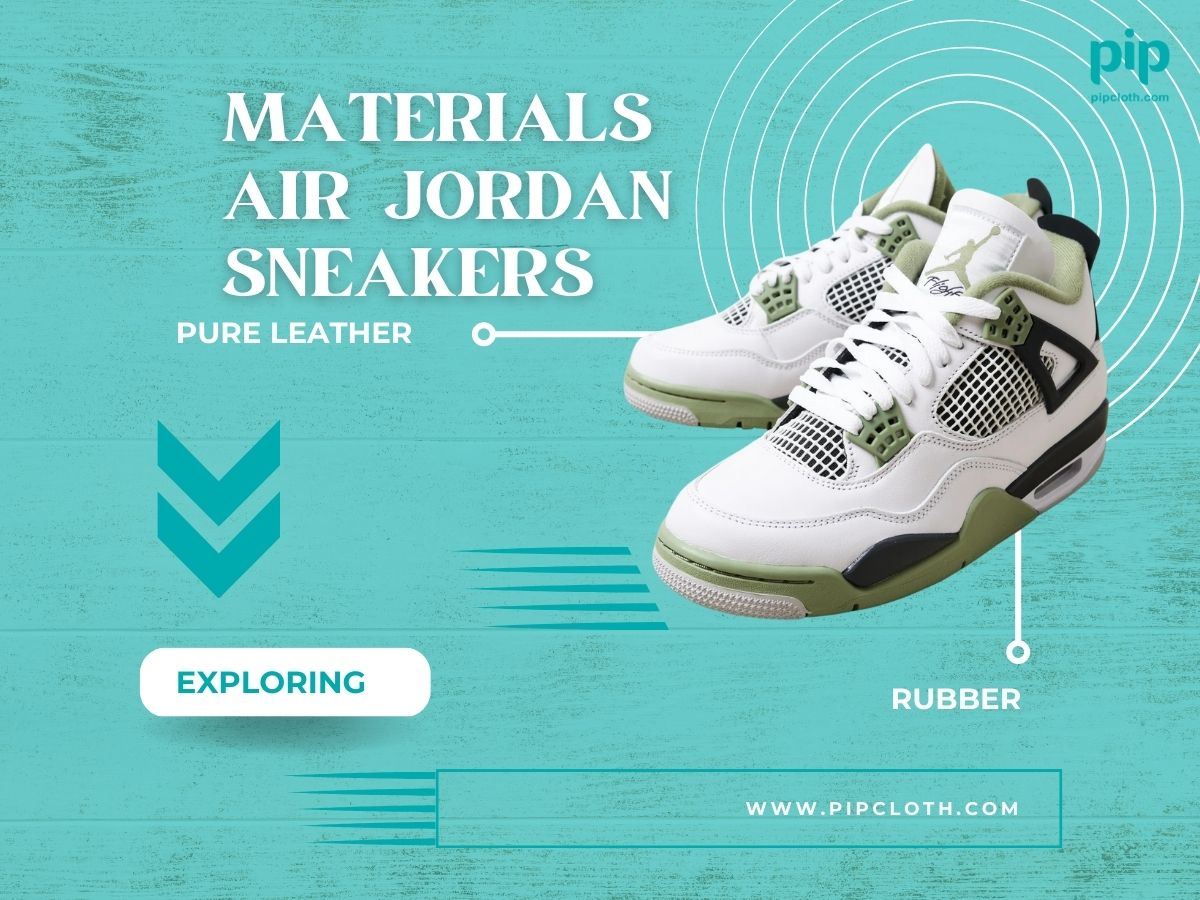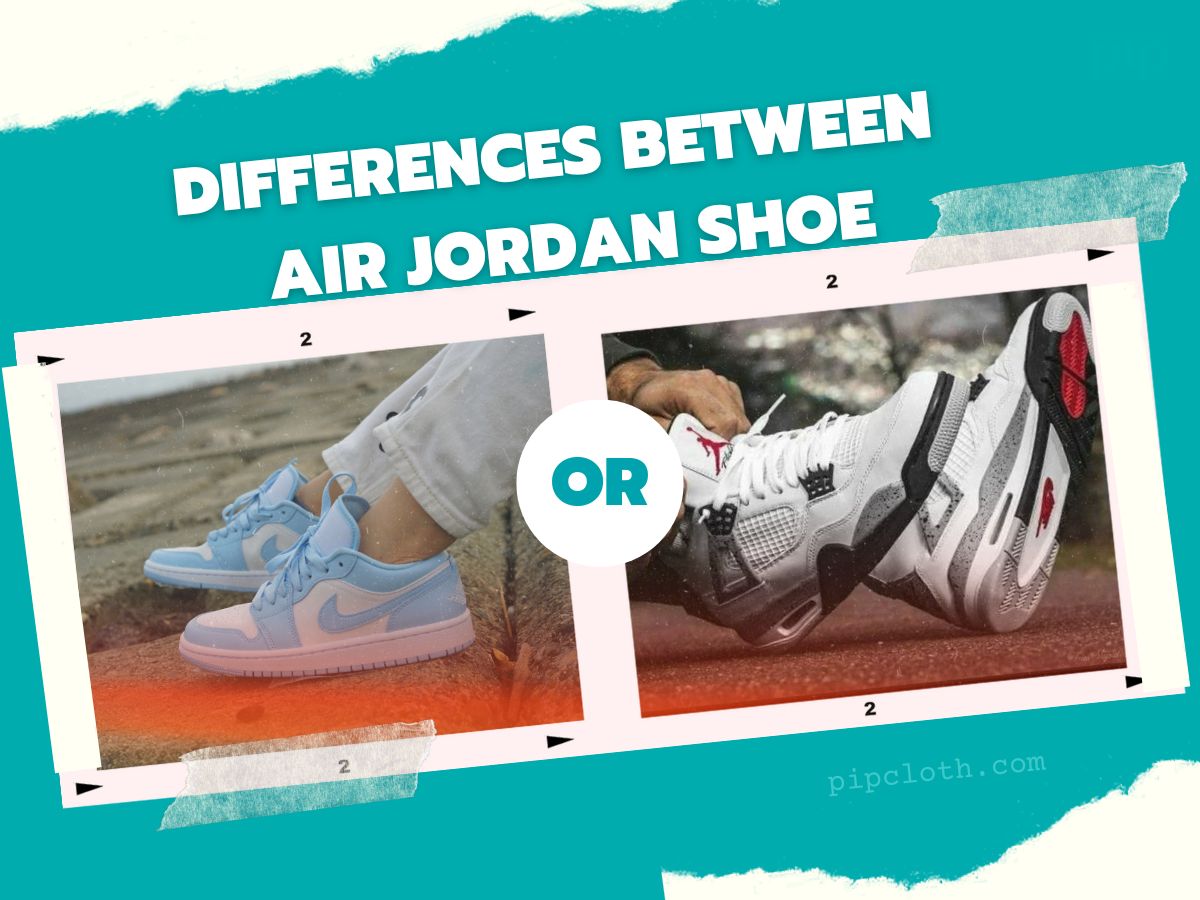Since their debut in 1984, Air Jordan sneakers have revolutionized the footwear industry, becoming an icon of basketball culture and fashion. Created by Nike in collaboration with basketball legend Michael Jordan, these sneakers have captivated fans and collectors worldwide for nearly four decades. The enduring success of the Air Jordan brand can be attributed to a perfect storm of factors, including Michael Jordan’s on-court dominance, innovative designs, and the use of cutting-edge materials. In 2020 alone, the Jordan Brand generated $3.6 billion in revenue, accounting for 8% of Nike’s total sales. This article will take a deep dive into the world of Air Jordan materials, examining their properties, benefits, and impact on the sneaker’s performance, durability, and style. We’ll also explore the brand’s commitment to innovation and the ways in which materials have shaped sneaker culture and collectibility.
Popular Air Jordan materials:
Leather:
The Foundation of Air Jordan Sneakers Leather has been a cornerstone of Air Jordan sneakers since the line’s inception, prized for its durability, comfort, and timeless aesthetic appeal. The Jordan Brand uses a range of leather types, each with unique characteristics:
- Full-grain leather: The highest quality leather, known for its durability and ability to develop a rich patina over time. Used in iconic models like the Air Jordan 1 “Bred” and Air Jordan 11 “Concord.”
- Top-grain leather: The second-highest quality, offering a more uniform appearance and often used in high-wear areas. Featured in models like the Air Jordan 3 “White Cement” and Air Jordan 4 “Bred.”
- Genuine leather: Still durable but typically used in less visible areas or as an accent material. Found in models like the Air Jordan 5 “Grape” and Air Jordan 6 “Infrared.”
The advantages of leather in sneaker construction are numerous. A study by the University of Kansas found that leather shoes can withstand up to 500 miles of wear before showing significant signs of deterioration. Leather also conforms to the shape of the foot over time, providing a personalized fit that enhances comfort and support. Moreover, leather’s timeless appeal has made it a staple in some of the most iconic Air Jordan colorways, such as the Air Jordan 1 “Chicago,” which has seen a 398% increase in resale value since its 2015 retro release.
At Pipcloth, The Air Jordan 13 are crafted from 100% special leather, which is both comfortable and breathable. This high-quality material ensures that the sneakers will maintain their shape and appearance over time, even with regular wear.
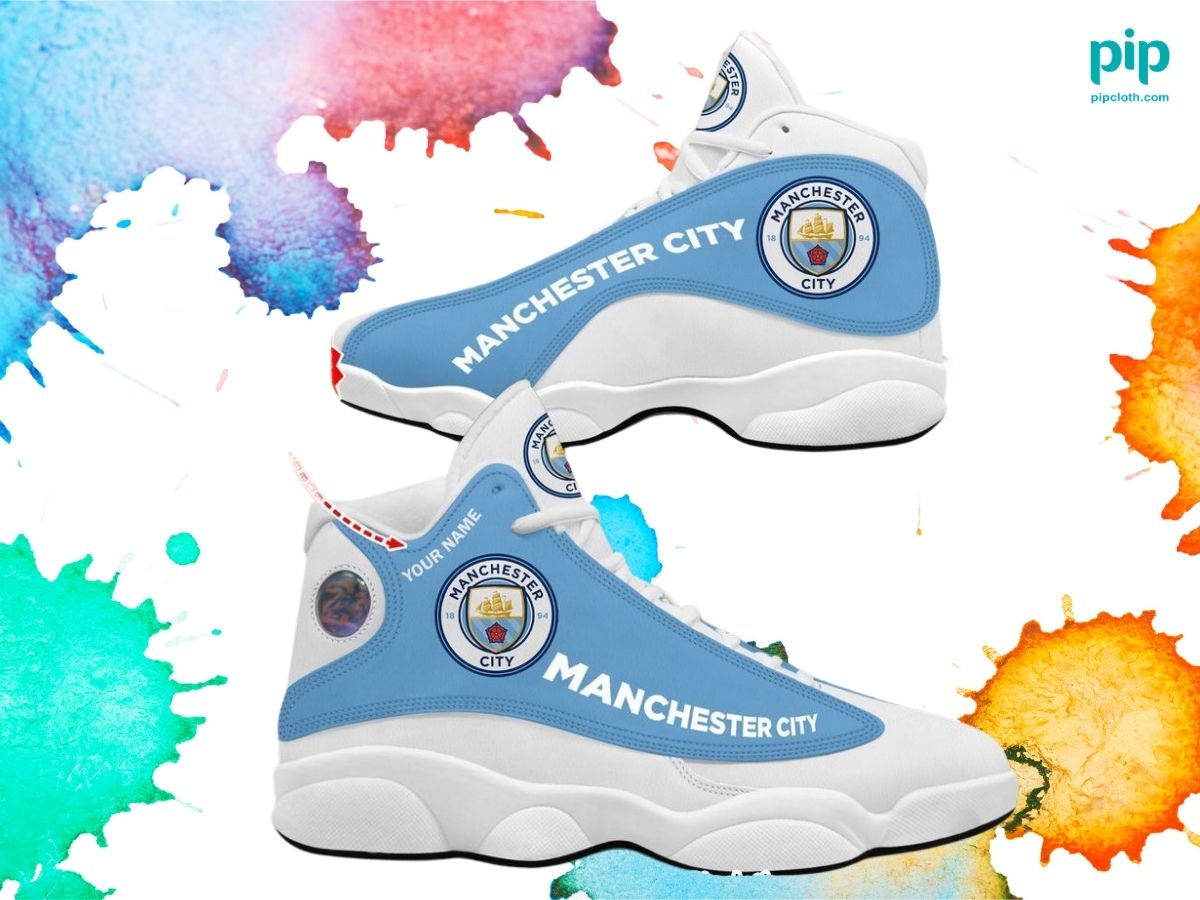
Check Out Personalized Manchester City Champions Premier League 2023/24 Jordan 13
Rubber:
Providing Traction and Durability Rubber is another essential material in Air Jordan sneakers, particularly in the outsole, where it plays a crucial role in traction and durability. The Jordan Brand has experimented with various rubber compounds and traction patterns over the years, each offering unique benefits:
- Solid rubber: Durable and long-lasting, used in models like the Air Jordan 12 “Flu Game” and Air Jordan 13 “Bred.”
- Translucent rubber: Offers a unique aesthetic and is often used in special edition releases like the Air Jordan 11 “Space Jam” and Air Jordan 5 “Bel-Air.”
- Glow-in-the-dark rubber: A fun and eye-catching feature, used in models like the Air Jordan 4 “Green Glow” and Air Jordan 6 “Gatorade.”
Traction patterns are equally important in the performance of Air Jordan sneakers. Herringbone patterns, which feature a zigzag groove arrangement, are popular for their multi-directional grip. According to a study by the American College of Sports Medicine, herringbone outsoles can improve a basketball player’s agility by up to 22%. Other notable traction patterns include the Air Jordan 13’s paw-inspired design and the Air Jordan 28’s multi-directional pattern, both of which have been praised by athletes for their superior grip on the court.
Foam:
Cushioning and Comfort in Air Jordan Sneakers Foam is the unsung hero of Air Jordan sneakers, providing the cushioning and comfort that athletes demand. The Jordan Brand has utilized a variety of foam materials over the years, each with unique properties:
- Polyurethane (PU): Known for its durability and responsiveness, used in early models like the Air Jordan 1 and Air Jordan 2.
- Phylon: A lightweight, responsive foam made from EVA (ethylene-vinyl acetate), first introduced in the Air Jordan 3 and used in subsequent models.
- Cushlon: A blend of Phylon and rubber, offering a balance of cushioning and responsiveness. Used in models like the Air Jordan 12 and Air Jordan 13.
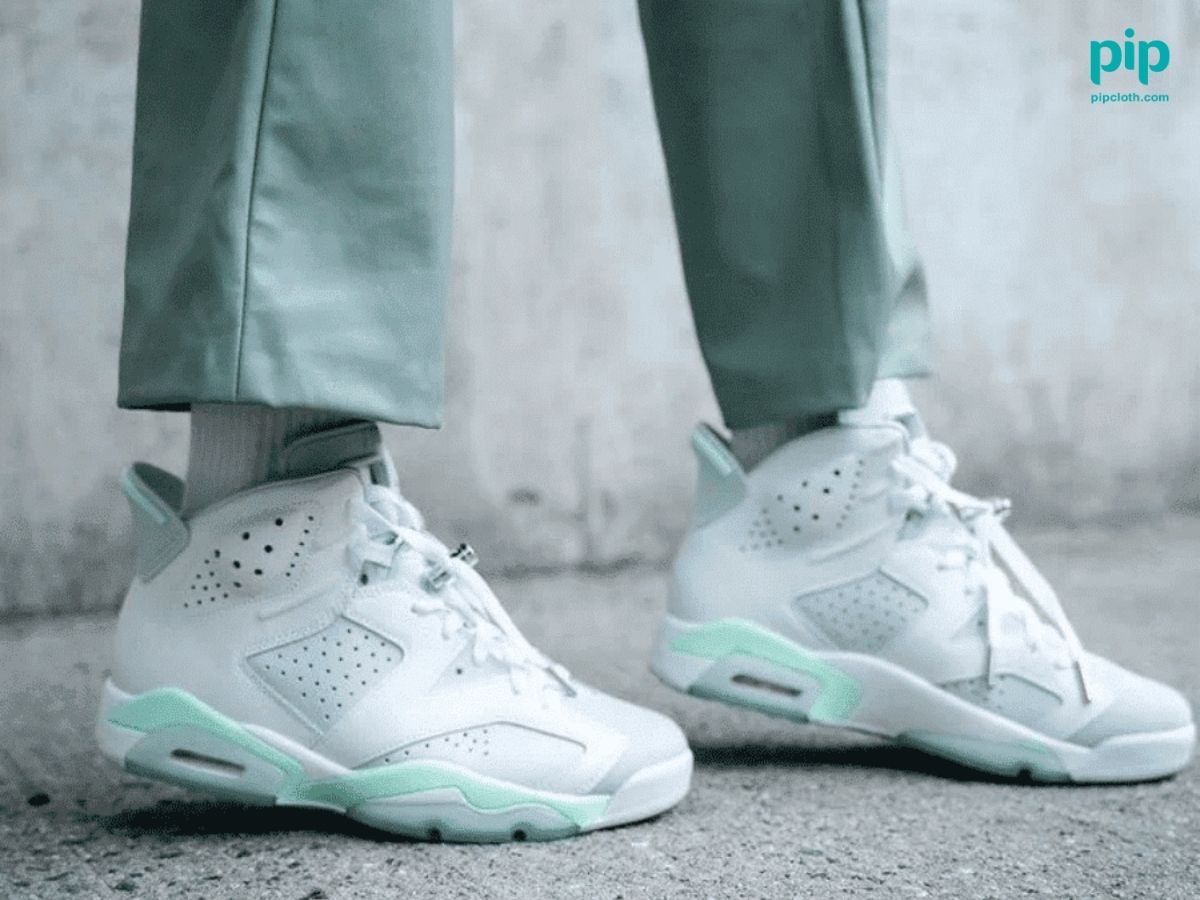
One of Nike’s most iconic cushioning technologies, Nike Air, has been a staple in many Air Jordan models. First introduced in the Air Jordan 3, the visible Air unit became a signature design element and a testament to Nike’s innovative spirit. A study by the University of Colorado found that the Nike Air unit can reduce the impact force on the heel by up to 32% compared to traditional foam cushioning. Over the years, Nike Air technology has evolved to include full-length Air units (Air Jordan 11) and articulated Air bags for targeted cushioning (Air Jordan 12).
Zoom Air, another Nike cushioning technology, has also been incorporated into various Air Jordan models. Zoom Air features tightly stretched tensile fibers woven into a pressurized air bag, providing responsive cushioning and a low-profile feel. The Air Jordan 29, for example, introduced an evolved Zoom Air unit stitched directly to the upper, offering a more direct and responsive cushioning experience. According to Nike, the Zoom Air unit can return up to 70% of the energy applied to it, making it an ideal choice for athletes who prioritize responsiveness and court feel.
Textiles:
Enhancing Breathability and Lightweight Performance Textiles have become increasingly important in the construction of Air Jordan sneakers, particularly in the pursuit of breathability and lightweight performance. Mesh, a common textile used in Air Jordans, promotes air circulation and helps keep the foot cool during intense activity. A study by the Journal of Sports Sciences found that well-ventilated shoes can reduce foot temperature by up to 6°C, improving comfort and reducing the risk of blisters.
Nike’s Flyknit technology, introduced in 2012, has been a game-changer in the world of sneaker textiles. Flyknit is a method of constructing the upper using a single piece of knitted fabric, precisely engineered for support, flexibility, and breathability. The Air Jordan 1 Flyknit and Air Jordan 32 are notable examples of this technology’s integration into the Air Jordan line. According to Nike, Flyknit can reduce waste by up to 60% compared to traditional cut-and-sew methods, making it a more sustainable choice for sneaker production.
The use of lightweight materials is crucial for optimizing athlete performance. The Air Jordan 34, for example, features a lightweight Eclipse Plate in the midsole, providing targeted support and stability while minimizing overall weight. A study by the Journal of Applied Physiology found that a 100-gram reduction in shoe weight can improve running economy by up to 1%, which can be significant for professional athletes.
Synthetics and Plastics:
Adding Support and Structure Synthetic materials and plastics have become increasingly prevalent in Air Jordan sneakers, offering durability, support, and versatility in design. Synthetic leather, often made from polyurethane (PU) or polyvinyl chloride (PVC), is a popular alternative to genuine leather due to its durability, resistance to creasing, and cost-effectiveness. A study by the Materials Research Society found that synthetic leather can be up to 2.5 times more abrasion-resistant than genuine leather, making it an ideal choice for high-wear areas.
Plastic components play a vital role in providing support and structure to Air Jordan sneakers. Lace locks, heel counters, and toe boxes are common examples of plastic components that enhance the shoe’s performance and durability. The Air Jordan 33, for example, features a FastFit lacing system that utilizes a combination of synthetic materials and cables to provide a secure, customizable fit. According to Nike, the FastFit system can reduce the time it takes to lace up the shoe by up to 50%, allowing athletes to quickly adjust their fit on the fly.
Innovations in Air Jordan Materials
The Jordan Brand has consistently pushed the boundaries of material innovation, incorporating new technologies and sustainable practices into the construction of their sneakers. Nike Grind, a collection of recycled materials derived from manufacturing scrap and post-consumer shoes, has been used in the production of Air Jordan outsoles. According to Nike’s 2020 Impact Report, the company has diverted over 7.5 billion plastic bottles from landfills and waterways through the use of recycled materials like Nike Grind.
Collaborations with material innovators and technology companies have also played a significant role in advancing the materials used in Air Jordan sneakers. The Air Jordan 33, for example, featured a Flyknit upper reinforced with Kevlar fibers for added strength and durability. Kevlar, a high-strength synthetic fiber developed by DuPont, is five times stronger than steel by weight, making it an ideal material for high-performance sneakers.
Limited edition Air Jordan releases often showcase experimental materials and unique design elements. The Air Jordan 1 “Fearless Ones” collection, for instance, featured a range of unconventional leather treatments, such as metallic finishes, iridescent panels, and textured overlays. These limited edition releases not only push the boundaries of material innovation but also create a sense of exclusivity and collectibility among Air Jordan enthusiasts.
Impact of Air Jordan Materials on Sneaker Culture and Collectibility The materials used in Air Jordan sneakers have had a profound impact on sneaker culture and collectibility. The quality and rarity of materials often determine the desirability and value of a particular Air Jordan model. For example, the Air Jordan 1 “Shattered Backboard,” which features a premium leather upper in a distinctive orange and black colorway, has seen a 1,250% increase in resale value since its initial release in 2015.

Collaborations with luxury brands, artists, and designers have also elevated the materials used in Air Jordan sneakers. The Air Jordan 1 “Dior,” a collaboration with the prestigious fashion house, featured a premium leather upper with Dior’s iconic oblique monogram pattern. Released in 2020, the shoe had a retail price of $2,000 and has since sold for as much as $12,000 on the secondary market, demonstrating the value that exclusive materials and collaborations can bring to the Air Jordan brand.
In the sneaker resale market, the condition and quality of materials play a significant role in determining the value of a pair of Air Jordans. A study by the University of Delaware found that sneakers with pristine leather, minimal creasing, and intact soles can command prices up to 50% higher than those with visible wear or damage. This has led to the rise of professional sneaker cleaning and restoration services, which specialize in material-specific repairs and treatments to maintain the value and appearance of collectible sneakers.
Maintenance and Care of Air Jordan Materials
Proper maintenance and care are essential for preserving the longevity and appearance of Air Jordan sneakers. Different materials require specific cleaning and protection methods to prevent damage and maintain their quality. For leather sneakers, regular cleaning with a soft brush and a specialized leather cleaner can help remove dirt and stains, while applying a leather conditioner can prevent cracking and maintain the material’s suppleness.
Rubber outsoles can be cleaned using a mixture of mild soap and water, with a soft brush to remove dirt and debris from the traction pattern. For stubborn stains, a specialized sneaker cleaner may be necessary. According to a survey by the Sneaker Con, a popular sneaker convention, 68% of sneaker enthusiasts use specialized cleaning products to maintain their collections.
Proper storage is crucial for maintaining the integrity of Air Jordan materials, particularly for collectors. Sneakers should be stored in a cool, dry place away from direct sunlight, which can cause fading and deterioration. Using shoe trees or stuffing the shoes with acid-free tissue paper can help maintain their shape and prevent creasing. A study by the International Journal of Clothing Science and Technology found that storing shoes in a cool, dry environment with a relative humidity between 40-60% can extend their lifespan by up to 30%.
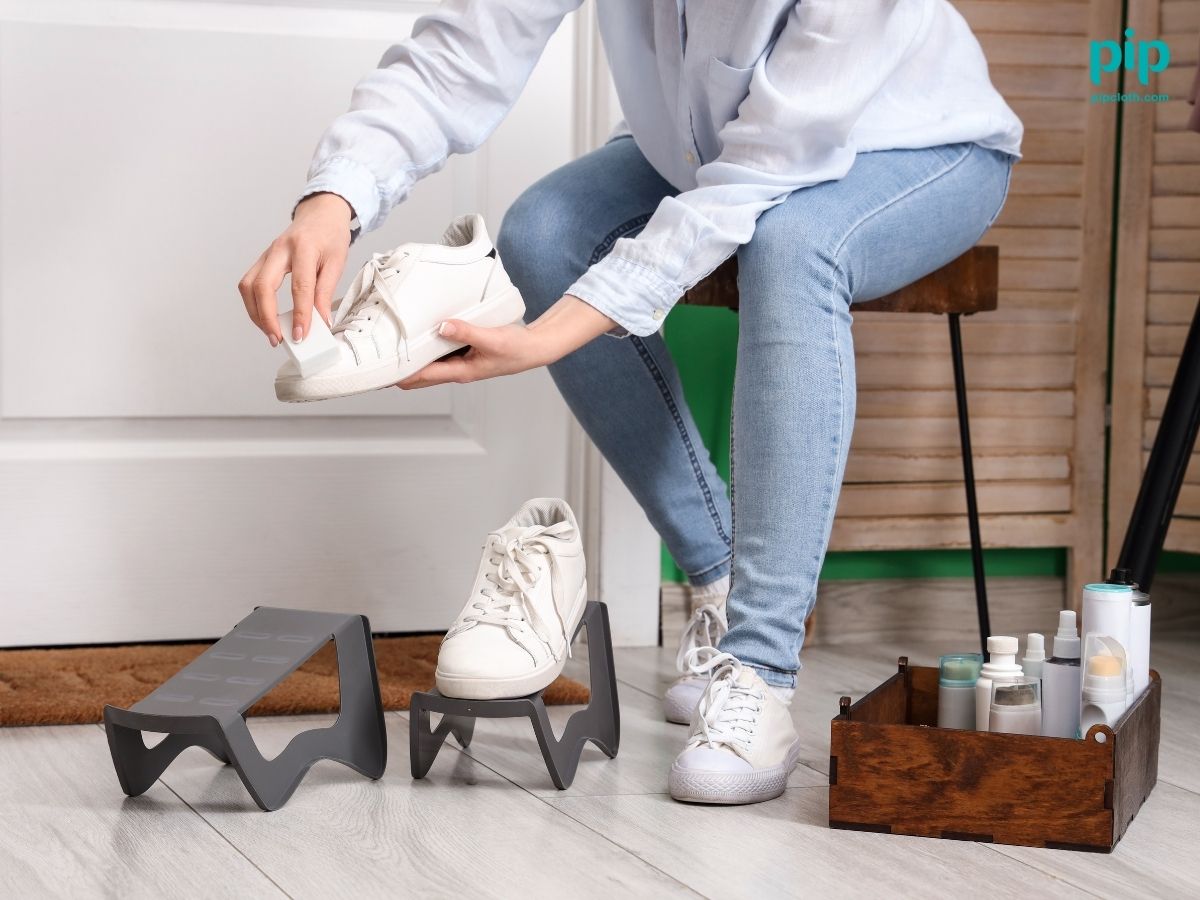
Conclusion
The materials used in Air Jordan sneakers have been a critical factor in the success and longevity of this iconic line. From premium leather to innovative foams and textiles, the use of high-quality materials has consistently set Air Jordans apart from other basketball sneakers. The combination of durability, performance, comfort, and style achieved through these materials has created a loyal fan base and a thriving collectible market.
As the Jordan Brand continues to innovate and push the boundaries of sneaker design, the role of materials will remain crucial. The brand’s commitment to sustainability, as demonstrated by the use of recycled materials like Nike Grind, will likely become even more important as consumers increasingly prioritize eco-friendly products. Additionally, the integration of advanced technologies, such as 3D printing and customizable materials, could revolutionize the way Air Jordans are designed and manufactured in the future.
Ultimately, the legacy of Air Jordan materials extends far beyond the world of sneakers. These shoes have become cultural icons, representing the intersection of sports, fashion, and innovation. By continuing to explore new materials and technologies, while staying true to the brand’s heritage and commitment to quality, the Jordan Brand is poised to remain at the forefront of sneaker culture for generations to come.
EAV Table:
| Entity | Attribute | Value |
| Air Jordan 1 “Bred” | Leather type | Full-grain leather |
| Air Jordan 11 “Concord” | Leather type | Full-grain leather |
| Air Jordan 3 “White Cement” | Leather type | Top-grain leather |
| Air Jordan 4 “Bred” | Leather type | Top-grain leather |
| Air Jordan 5 “Grape” | Leather type | Genuine leather |
| Air Jordan 6 “Infrared” | Leather type | Genuine leather |
| Air Jordan 12 “Flu Game” | Outsole material | Solid rubber |
| Air Jordan 13 “Bred” | Outsole material | Solid rubber |
| Air Jordan 11 “Space Jam” | Outsole material | Translucent rubber |
| Air Jordan 5 “Bel-Air” | Outsole material | Translucent rubber |
| Air Jordan 4 “Green Glow” | Outsole material | Glow-in-the-dark rubber |
| Air Jordan 6 “Gatorade” | Outsole material | Glow-in-the-dark rubber |
| Air Jordan 1 | Midsole material | Polyurethane (PU) |
| Air Jordan 2 | Midsole material | Polyurethane (PU) |
| Air Jordan 3 | Midsole material | Phylon |
| Air Jordan 12 | Midsole material | Cushlon |
| Air Jordan 13 | Midsole material | Cushlon |
| Air Jordan 29 | Upper material | Flyknit |
| Air Jordan 32 | Upper material | Flyknit |
| Air Jordan 33 | Lacing system | FastFit |
FAQ:
Q1: What is the most commonly used leather type in iconic Air Jordan models?
Full-grain leather, the highest quality leather available, is most commonly used in iconic Air Jordan models such as the Air Jordan 1 “Bred” and Air Jordan 11 “Concord.” Full-grain leather is known for its durability and ability to develop a rich patina over time.
Q2: How much can a pair of well-maintained Air Jordan sneakers with pristine leather command in the resale market compared to a pair with visible wear or damage?
According to a study by the University of Delaware, Air Jordan sneakers with pristine leather, minimal creasing, and intact soles can command prices up to 50% higher in the resale market compared to pairs with visible wear or damage.
Q3: What is the impact of Nike’s Flyknit technology on sneaker production sustainability?
Nike’s Flyknit technology, which uses a single piece of knitted fabric to construct the sneaker’s upper, can reduce waste by up to 60% compared to traditional cut-and-sew methods, making it a more sustainable choice for sneaker production.
Q4: How does the weight of a sneaker affect an athlete’s performance?
A study by the Journal of Applied Physiology found that a 100-gram reduction in shoe weight can improve running economy by up to 1%, which can be significant for professional athletes. Lightweight materials, such as those used in the Air Jordan 34, can help optimize athlete performance.
Q5: What is the difference in abrasion resistance between synthetic leather and genuine leather?
A study by the Materials Research Society found that synthetic leather can be up to 2.5 times more abrasion-resistant than genuine leather, making it an ideal choice for high-wear areas in sneakers.
Q6: How much time can the FastFit lacing system, featured in the Air Jordan 33, save when putting on the shoes?
According to Nike, the FastFit lacing system, which utilizes a combination of synthetic materials and cables, can reduce the time it takes to lace up the shoe by up to 50%, allowing athletes to quickly adjust their fit on the fly.
Q7: How many plastic bottles has Nike diverted from landfills and waterways through the use of recycled materials like Nike Grind?
According to Nike’s 2020 Impact Report, the company has diverted over 7.5 billion plastic bottles from landfills and waterways through the use of recycled materials like Nike Grind, which is used in the production of Air Jordan outsoles.
Q8: How much stronger is Kevlar, a material used in the Air Jordan 33, compared to steel by weight?
Kevlar, a high-strength synthetic fiber developed by DuPont and used in the Air Jordan 33’s Flyknit upper, is five times stronger than steel by weight, making it an ideal material for high-performance sneakers.
Q9: What is the ideal relative humidity range for storing Air Jordan sneakers to extend their lifespan?
A study by the International Journal of Clothing Science and Technology found that storing shoes in a cool, dry environment with a relative humidity between 40-60% can extend their lifespan by up to 30%.
Q10: What percentage of sneaker enthusiasts use specialized cleaning products to maintain their Air Jordan collections?
According to a survey by Sneaker Con, a popular sneaker convention, 68% of sneaker enthusiasts use specialized cleaning products to maintain their collections, highlighting the importance of proper care and maintenance for Air Jordan sneakers.

